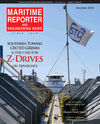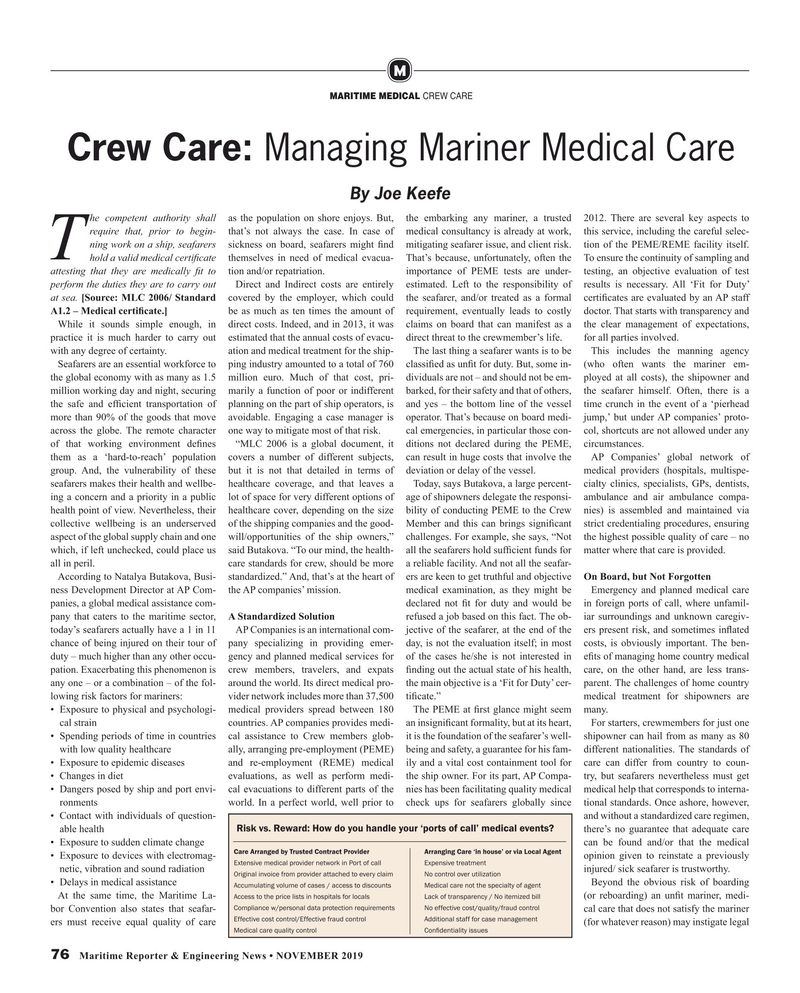
Page 76: of Maritime Reporter Magazine (November 2019)
Workboat Edition
Read this page in Pdf, Flash or Html5 edition of November 2019 Maritime Reporter Magazine
M
MARITIME MEDICAL CREW CARE
Crew Care: Managing Mariner Medical Care
By Joe Keefe he competent authority shall as the population on shore enjoys. But, the embarking any mariner, a trusted 2012. There are several key aspects to require that, prior to begin- that’s not always the case. In case of medical consultancy is already at work, this service, including the careful selec- ning work on a ship, seafarers sickness on board, seafarers might ? nd mitigating seafarer issue, and client risk. tion of the PEME/REME facility itself.
T hold a valid medical certi? cate themselves in need of medical evacua- That’s because, unfortunately, often the To ensure the continuity of sampling and attesting that they are medically ? t to tion and/or repatriation. importance of PEME tests are under- testing, an objective evaluation of test perform the duties they are to carry out Direct and Indirect costs are entirely estimated. Left to the responsibility of results is necessary. All ‘Fit for Duty’ at sea. [Source: MLC 2006/ Standard covered by the employer, which could the seafarer, and/or treated as a formal certi? cates are evaluated by an AP staff
A1.2 – Medical certi? cate.] be as much as ten times the amount of requirement, eventually leads to costly doctor. That starts with transparency and
While it sounds simple enough, in direct costs. Indeed, and in 2013, it was claims on board that can manifest as a the clear management of expectations, practice it is much harder to carry out estimated that the annual costs of evacu- direct threat to the crewmember’s life. for all parties involved. with any degree of certainty. ation and medical treatment for the ship- The last thing a seafarer wants is to be This includes the manning agency
Seafarers are an essential workforce to ping industry amounted to a total of 760 classi? ed as un? t for duty. But, some in- (who often wants the mariner em- the global economy with as many as 1.5 million euro. Much of that cost, pri- dividuals are not – and should not be em- ployed at all costs), the shipowner and million working day and night, securing marily a function of poor or indifferent barked, for their safety and that of others, the seafarer himself. Often, there is a the safe and ef? cient transportation of planning on the part of ship operators, is and yes – the bottom line of the vessel time crunch in the event of a ‘pierhead more than 90% of the goods that move avoidable. Engaging a case manager is operator. That’s because on board medi- jump,’ but under AP companies’ proto- across the globe. The remote character one way to mitigate most of that risk. cal emergencies, in particular those con- col, shortcuts are not allowed under any of that working environment de? nes “MLC 2006 is a global document, it ditions not declared during the PEME, circumstances.
them as a ‘hard-to-reach’ population covers a number of different subjects, can result in huge costs that involve the AP Companies’ global network of group. And, the vulnerability of these but it is not that detailed in terms of deviation or delay of the vessel. medical providers (hospitals, multispe- seafarers makes their health and wellbe- healthcare coverage, and that leaves a Today, says Butakova, a large percent- cialty clinics, specialists, GPs, dentists, ing a concern and a priority in a public lot of space for very different options of age of shipowners delegate the responsi- ambulance and air ambulance compa- health point of view. Nevertheless, their healthcare cover, depending on the size bility of conducting PEME to the Crew nies) is assembled and maintained via collective wellbeing is an underserved of the shipping companies and the good- Member and this can brings signi? cant strict credentialing procedures, ensuring aspect of the global supply chain and one will/opportunities of the ship owners,” challenges. For example, she says, “Not the highest possible quality of care – no which, if left unchecked, could place us said Butakova. “To our mind, the health- all the seafarers hold suf? cient funds for matter where that care is provided.
all in peril. care standards for crew, should be more a reliable facility. And not all the seafar-
According to Natalya Butakova, Busi- standardized.” And, that’s at the heart of ers are keen to get truthful and objective On Board, but Not Forgotten ness Development Director at AP Com- the AP companies’ mission. medical examination, as they might be Emergency and planned medical care panies, a global medical assistance com- declared not ? t for duty and would be in foreign ports of call, where unfamil- pany that caters to the maritime sector, A Standardized Solution refused a job based on this fact. The ob- iar surroundings and unknown caregiv- today’s seafarers actually have a 1 in 11 AP Companies is an international com- jective of the seafarer, at the end of the ers present risk, and sometimes in? ated chance of being injured on their tour of pany specializing in providing emer- day, is not the evaluation itself; in most costs, is obviously important. The ben- duty – much higher than any other occu- gency and planned medical services for of the cases he/she is not interested in e? ts of managing home country medical pation. Exacerbating this phenomenon is crew members, travelers, and expats ? nding out the actual state of his health, care, on the other hand, are less trans- any one – or a combination – of the fol- around the world. Its direct medical pro- the main objective is a ‘Fit for Duty’ cer- parent. The challenges of home country lowing risk factors for mariners: vider network includes more than 37,500 ti? cate.” medical treatment for shipowners are • Exposure to physical and psychologi- medical providers spread between 180 The PEME at ? rst glance might seem many. cal strain countries. AP companies provides medi- an insigni? cant formality, but at its heart, For starters, crewmembers for just one • Spending periods of time in countries cal assistance to Crew members glob- it is the foundation of the seafarer’s well- shipowner can hail from as many as 80 with low quality healthcare ally, arranging pre-employment (PEME) being and safety, a guarantee for his fam- different nationalities. The standards of • Exposure to epidemic diseases and re-employment (REME) medical ily and a vital cost containment tool for care can differ from country to coun- • Changes in diet evaluations, as well as perform medi- the ship owner. For its part, AP Compa- try, but seafarers nevertheless must get • Dangers posed by ship and port envi- cal evacuations to different parts of the nies has been facilitating quality medical medical help that corresponds to interna- ronments world. In a perfect world, well prior to check ups for seafarers globally since tional standards. Once ashore, however, • Contact with individuals of question- and without a standardized care regimen,
Risk vs. Reward: How do you handle your ‘ports of call’ medical events? able health there’s no guarantee that adequate care • Exposure to sudden climate change can be found and/or that the medical
Care Arranged by Trusted Contract Provider Arranging Care ‘in house’ or via Local Agent • Exposure to devices with electromag- opinion given to reinstate a previously
Extensive medical provider network in Port of call Expensive treatment netic, vibration and sound radiation injured/ sick seafarer is trustworthy.
Original invoice from provider attached to every claim No control over utilization • Delays in medical assistance Beyond the obvious risk of boarding
Accumulating volume of cases / access to discounts Medical care not the specialty of agent
At the same time, the Maritime La- (or reboarding) an un? t mariner, medi-
Access to the price lists in hospitals for locals Lack of transparency / No itemized bill
Compliance w/personal data protection requirements No effective cost/quality/fraud control bor Convention also states that seafar- cal care that does not satisfy the mariner
Effective cost control/Effective fraud control Additional staff for case management ers must receive equal quality of care (for whatever reason) may instigate legal
Medical care quality control Con? dentiality issues 76 Maritime Reporter & Engineering News • NOVEMBER 2019
NEW 74 77.indd 76 NEW 74 77.indd 76 11/6/2019 3:33:58 PM11/6/2019 3:33:58 PM

 75
75

 77
77
